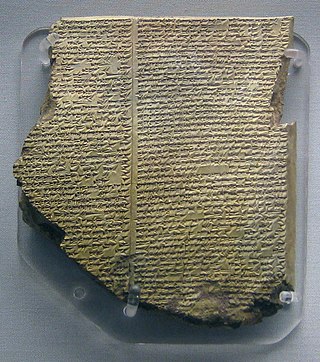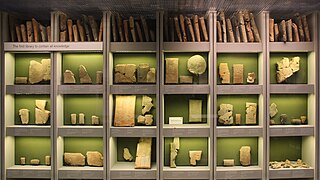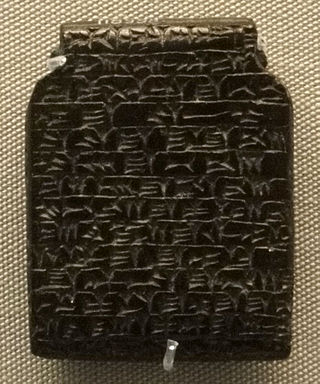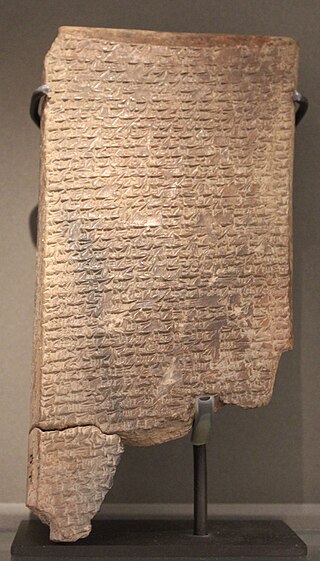Related Research Articles

The Hanging Gardens of Babylon were one of the Seven Wonders of the Ancient World listed by Hellenic culture. They were described as a remarkable feat of engineering with an ascending series of tiered gardens containing a wide variety of trees, shrubs, and vines, resembling a large green mountain constructed of mud bricks. It was said to have been built in the ancient city of Babylon, near present-day Hillah, Babil province, in Iraq. The Hanging Gardens' name is derived from the Greek word κρεμαστός, which has a broader meaning than the modern English word "hanging" and refers to trees being planted on a raised structure such as a terrace.
Akkadian literature is the ancient literature written in the Akkadian language in Mesopotamia during the period spanning the Middle Bronze Age to the Iron Age.

The Epic of Gilgamesh is an epic poem from ancient Mesopotamia. The literary history of Gilgamesh begins with five Sumerian poems about Bilgamesh, king of Uruk, dating from the Third Dynasty of Ur. These independent stories were later used as source material for a combined epic in Akkadian. The first surviving version of this combined epic, known as the "Old Babylonian" version, dates back to the 18th century BC and is titled after its incipit, Shūtur eli sharrī. Only a few tablets of it have survived. The later Standard Babylonian version compiled by Sîn-lēqi-unninni dates from the 13th to the 10th centuries BC and bears the incipit Sha naqba īmuru. Approximately two-thirds of this longer, twelve-tablet version have been recovered. Some of the best copies were discovered in the library ruins of the 7th-century BC Assyrian king Ashurbanipal.

Sippar was an ancient Near Eastern Sumerian and later Babylonian city on the east bank of the Euphrates river. Its tell is located at the site of modern Tell Abu Habbah near Yusufiyah in Iraq's Baghdad Governorate, some 69 km (43 mi) north of Babylon and 30 km (19 mi) southwest of Baghdad. The city's ancient name, Sippar, could also refer to its sister city, Sippar-Amnanum ; a more specific designation for the city here referred to as Sippar was Sippar-Yahrurum.

Enūma Eliš is the Babylonian creation myth. It was recovered by English archaeologist Austen Henry Layard in 1849 in the ruined Library of Ashurbanipal at Nineveh. A form of the myth was first published by English Assyriologist George Smith in 1876; active research and further excavations led to near completion of the texts and improved translation.

Anzû, also known as dZû and Imdugud, is a lesser devi monster in several Mesopotamian religions. He was conceived by the pure waters of the Apsu and the wide Earth, or as son of Siris. Anzû was depicted as a massive bird who can breathe fire and water, although Anzû is alternately depicted as a lion-headed eagle.

The Royal Library of Ashurbanipal, named after Ashurbanipal, the last great king of the Assyrian Empire, is a collection of more than 30,000 clay tablets and fragments containing texts of all kinds from the 7th century BC, including texts in various languages. Among its holdings was the famous Epic of Gilgamesh.

Erra is an Akkadian plague god known from an 'epos' of the eighth century BCE. Erra is the god of mayhem and pestilence who is responsible for periods of political confusion. He was assimilated to Nergal at some point.

Ludlul bēl nēmeqi, also sometimes known in English as The Poem of the Righteous Sufferer, is a Mesopotamian poem written in Akkadian that concerns itself with the problem of the unjust suffering of an afflicted man, named Šubši-mašrâ-Šakkan (Shubshi-meshre-Shakkan). The author is tormented, but he does not know why. He has been faithful in all of his duties to the gods. He speculates that perhaps what is good to man is evil to the gods and vice versa. He is ultimately delivered from his sufferings. It is thought to have been composed during the reign of Kassite king of Babylon Nazi-Maruttaš, who is mentioned on line 105 of tablet IV.

The "Debate between sheep and grain" or "Myth of cattle and grain" is a Sumerian creation myth, written on clay tablets in the mid to late 3rd millennium BC.

The Debate between Winter and Summer or Myth of Emesh and Enten is a Sumerian creation myth, written on clay tablets in the mid to late 3rd millennium BC.
The Cuthean Legend of Naram-Sin is one of the few literary works whose versions are attested in both Old Babylonian, Middle Babylonian and the Standard Babylonian of the late Neo-Babylonian period, a literary life of around 1,500 years. It seems to have earlier been titled ṭupšenna pitēma, or "Open the Tablet Box" after its incipit and was re-titled Naram-Sin and the Enemy Hordes, after its subject matter by its last Babylonian editor.
Counsels of Wisdom is a piece of Babylonian wisdom literature written in Akkadian containing moral exhortations. It is composed primarily of two-line units, without sections. A translation of extant portions of the text was published in Lambert 1996. Existing manuscripts are fragmentary, but the original was estimated to be about 160 lines.

The Akkadian composition Advice to a Prince, also known as Babylonischer Fürstenspiegel, calls on future kings and magnates to heed justice. More particularly, it exhorts them to respect the special status of the three ancient Babylonian cities Sippar, Nippur and Babylon, whose citizens are presented as exempted from forced labor and taxes by divine decision. In a casuistic structure reminiscent of both law and omen treatises, the text lists the divine punishments reserved for the powerful who do not abide by its clauses.
Palm and Vine is a work of Akkadian literature. It contains a disputation poem between two litigants, Palm and Vine, each of which praises its own merits and many uses, and discredits those of its rival. The text may have been composed in the second-millennium BCE, but only first-millennium manuscripts of it are known. Fifty-four lines from the middle section of the text are preserved, which begin in medias res with a long speech of Palm, immediately followed by Vine’s rejoinder. Three library manuscripts of the poem are known, as well as an excerpt on a peculiar school tablet.
The Story of the Poor, Forlorn Wren is a work of Akkadian literature, preserved only in late manuscripts. It contains a fable featuring a wren and an eagle. It is an example of poetic expression in the literature of Iraq in the first millennium BCE.
The Hymn to the Queen of Nippur is a piece of Akkadian literature.
Bullussa-rabi’s Hymn to Gula is a piece of Akkadian literature.
The Syncretistic Hymn to Ištar is a piece of Akkadian literature.
The Great Hymn of Ištar is a piece of Akkadian literature.
References
- 1 2 Jiménez, Enrique (2017-02-06). The Babylonian Disputation Poems: With Editions of the Series of the Poplar, Palm and Vine, the Series of the Spider, and the Story of the Poor, Forlorn Wren. Brill. pp. 157–159. doi:10.1163/9789004336261. ISBN 978-90-04-33626-1.
- ↑ Jiménez, Enrique (2020). "Disputation Poems in Nineveh". Disputation Literature in the Near East and Beyond. Berlin: de Gruyter. ISBN 9781501510274.
- ↑ Jiménez, Enrique (2021). "Literature II.12 Palm and Vine". Electronic Babylonian Library. doi:10.5282/EBL/L/2/12.
- ↑ Jiménez, Enrique (2021). "Literature II.8 Series of the Poplar". Electronic Babylonian Library. doi:10.5282/EBL/L/2/8.
- ↑ Mitto, Tonio D. N. (2022). "Literature 0.0 Catalogue of Texts and Authors". Hätinen, Aino, Heinrich, Adrian C., Jiménez, Enrique. doi:10.5282/EBL/L/0/0.
{{cite journal}}: Cite journal requires|journal=(help) - ↑ Lambert, W.G. (1960). Babylonian Wisdom Literature. Oxford: Clarendon Press.